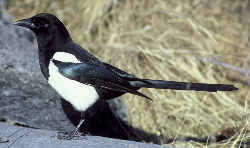Black-billed Magpie
From Wikipedia, the free encyclopedia
[Photo] black-billed magpie public domain USFWA
The Black-billed Magpie is a large bird in the crow family that occurs in the western half of North America from Alaska to Oklahoma. Externally, it is almost identical with European Magpie, Pica pica, and is considered conspecific by many sources. The American Ornithologists' Union, however, splits it as a separate species, Pica hudsonia, on the grounds that mtDNA sequence studies place it closer to California's Yellow-billed Magpie, Pica nuttalli, than to the European Magpie. If this view is correct, the Korean subspecies of the European Magpie, Pica pica sericea, should also be considered a separate species (Lee et al., 2003).
It appears that after the ancestral magpie spread over Eurasia, the Korean population became isolated and only after that was North America colonized via Beringia, where the two American magpies then differentiated. Fossil evidence (Miller & Bowman, 1956) indicates that the ancestral North American magpies had arrived in its current range around the mid-late Pliocene (c. 3-4 mya) and that the Yellow-billed Magpie lineage split off rather soon thereafter due to the Sierra Nevada uplift and the beginning ice ages. The comparatively low genetic difference, however, suggests that some gene flow between the Black-billed and Yellow-billed magpies still occurred during interglacial periods until the Pleistocene.
The Black-billed Magpie prefers semi-open country with some large bushes or trees. It is a common sight in many towns. It builds a bulky stick nest in a tree or bush, with a typical clutch of 8 or 9 brown-marked green-blue eggs. Both parents build the nest and feed the young, but the female alone incubates the eggs for about 17-18 days to hatching.
It is 43-50 cm long, with the male larger than the female. It has a black head, breast, lower belly and upperparts, white shoulders and primary wing feathers, dark blue inner wings, and a long graduated green and blue tail which makes up half this bird's total length.
The Black-billed Magpie is omnivorous, eating many types of insects, carrion, eggs and rodents, as well as berries, seeds and nuts, and also garbage and food from pets that are fed outside. It forages on the ground, but also may steal food from other birds.
It is mainly a permanent resident; some birds may move south or to lower elevations in winter, while others may wander east after the breeding season.
The call of this bird is a nasal inquisitive chug chug chug.
In spite of efforts of settlers to eradicate this bird at the beginning of the 20th century, they remain numerous and widespread.
http://en.wikipedia.org/wiki/Black-billed_Magpie
| The text in this page is based on the copyrighted Wikipedia article shown in above URL. It is used under the GNU Free Documentation License. You may redistribute it, verbatim or modified, providing that you comply with the terms of the GFDL. |
|

